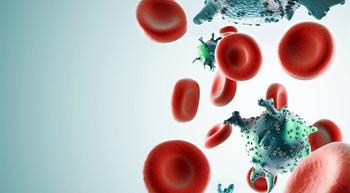
- Spring 2023
- Volume 22
- Issue 1
BTK Inhibitors Offer a Revolutionary Treatment of Relapsed CLL/SLL
Key Takeaways
- Penny Isop's CLL diagnosis revealed an aggressive form, leading to participation in a clinical trial with immunotherapy drugs, resulting in remission.
- Bruton tyrosine kinase (BTK) inhibitors, like Imbruvica, have transformed CLL treatment, though they can cause side effects such as atrial fibrillation.
Bruton tyrosine kinase inhibitors have changed the space for treating patients with CLL or SLL, with more on the way to potentially address drug resistance.
When Penny Isop was diagnosed with chronic lymphocytic leukemia (CLL) in July 2012, her doctor said it was a “good cancer” to have. Isop, then 65 years old, didn’t see it that way. She and her partner, David Needle, had recently relocated from Atlanta to Mount Pleasant, South Carolina, since they “needed a slower pace,” Isop says. She took a part-time job at a travel agency, where she worked until her diagnosis.
“I didn’t feel good about having cancer,” Isop recalls.
In fact, things weren’t good. Some people who receive a new CLL diagnosis can take a watch-and-wait approach, starting treatments only if the cancer progresses or symptoms worsen. This is because CLL is not generally curable but can be treated and even put into varying degrees of remission, where treatment may not be needed for some period of time.
However, within a month of her diagnosis, Isop was getting blood transfusions to treat stage 3 or 4 CLL. She was so fatigued and out of breath that the mere act of walking to her car was a struggle.
A subsequent bone marrow biopsy and gene test showed her CLL cells were missing part of the 11th chromosome (what’s known as CLL with an 11q deletion). This meant the cancer was more aggressive and less likely to respond to chemoimmunotherapy, the standard first-line treatment at the time. The test results also demonstrated that the CLL had an unmutated IGHV status, which is a molecular marker that’s typically linked with poorer prognosis and shorter survival.
Isop’s prognosis wasn’t as good as the doctor thought.
In October, Isop sought the advice of a New York City hematologist oncologist. “He said I was a perfect candidate for a clinical trial,” recalls Isop, “but I needed to be in New York for at least four months for treatment and monitoring.” She and Needle moved into an American Cancer Society Hope Lodge, which provides free housing for adults getting cancer treatments.
As a participant in the phase 2 ThRiL trial, Isop received alternating treatments of three immunotherapy drugs: Rituxan (rituximab), Revlimid (lenalidomide) and thalidomide. Her response to the treatments was remarkable, with the cancer quickly going into remission.
The trial followed a scheduled dose reduction, with Isop eventually taking just Revlimid every other day until the trial ended in December 2020.
“The hope was that the cancer would stay in remission after I stopped treatment,” Isop says.
At first, Isop’s blood labs looked promising. But by the end of the year, her white blood cell count had tripled, a sign the cancer cells were multiplying again. That’s when her doctor recommended an oral-targeted therapy known as Bruton tyrosine kinase (BTK) inhibitors.
What Are BTK Inhibiotrs?
“This enzyme transmits signals that promote the survival and uncontrolled growth of leukemic B-lymphocytes,” says Dr. Shuo Ma, a hematologist oncologist at Northwestern University’s Robert H. Lurie Comprehensive Cancer Center in Chicago. “BTK inhibitors cut off the signaling pathway, leading to leukemia cell death and disease remission.”
Imbruvica (ibrutinib) was the first BTK inhibitor to receive approval from the Food and Drug Administration (FDA). But that November 2013 approval was for mantle cell lymphoma, a rare and aggressive blood cancer. Three months later, in February 2014, the FDA approved the drug for CLL, but only for those who had tried at least one other treatment. In July, it extended the approval to those who had CLL with a 17p deletion, another difficult-to-treat form of CLL.
It wasn’t until March 2016 that the
The approval of a BTK inhibitor for CLL was a game changer for the more than 200,000 Americans living with the disease as well as the 18,000-plus people who will receive a CLL diagnosis this year.
“Imbruvica made an incredible impact for patients with CLL,” says Dr. Ian W. Flinn, director of lymphoma research for the Sarah Cannon Research Institute at Tennessee Oncology in Nashville. “People very sick with CLL who received this treatment oftentimes had near-complete resolution of their symptoms, including severe fatigue, fever and night sweats. They were able to enjoy life again.”
Side Effects of BTK Inhibitors
Still, Imbruvica, like all cancer treatments, has side effects. Among them: easy bleeding and bruising, anemia (low red blood cells), neutropenia (low neutrophils or white blood cells), fatigue, muscle and joint pain, diarrhea and respiratory infections.
It wasn’t until thousands of patients had taken the drug for years that another, more alarming side effect — atrial fibrillation (AFib) — became apparent. This heart rhythm problem (arrhythmia) can cause potentially life-threatening blood clots, strokes, heart failure and other cardiac events. Studies now show that people who take Imbruvica are 10 times more likely to develop AFib.
“CLL predominantly affects people in their 60s and 70s, an age group that’s more prone to heart problems,” says Flinn. “It took a while to connect that the drug was also a contributing factor to arrhythmias.”
Imbruvica is meant to target the BTK enzyme. But for reasons that aren’t clear, the drug sometimes homes in on and damages healthy enzymes critical for heart function. AFib may occur within a few months of starting the drug or years into treatment. An estimated 4 in 10 people stop taking Imbruvica because of adverse side effects, about 4% of them heart related.
Not everyone who takes Imbruvica for CLL develops an arrhythmia. Dr. Reshma Ramlal, a hematologist oncologist at the University of Kentucky Markey Cancer Center in Lexington and interim director of the center’s Bone Marrow Transplant and Cellular Therapy Program, has patients taking the treatment for years with great success and no heart issues.
“The good news for those who develop AFib is that the condition typically goes away when you stop the drug,” she says. “And it doesn’t appear to cause long-term heart damage.”
Even better news: Recent studies show that newer second-generation BTK inhibitors are more effective at treating CLL, and they’re less likely to affect the heart.
A New Generation of Treatment Options
In April 2018, Dayton, Ohio, resident Brenda Duggins enrolled in a clinical trial for one of the newer BTK inhibitors, Calquence (acalabrutinib). The trial combined the drug with two other targeted therapy drugs, Rituxan and Venclexta (venetoclax). At the time, Calquence had FDA approval for mantle cell lymphoma (just as its predecessor Imbruvica had started out), but not CLL, and tends to have fewer side effects than Imbruvica.
Duggins was aged 62 years when she learned she had CLL in June 2012. By October, the disease had her feeling so poorly, she could barely leave her bed. Her doctor started her on an intensive 12-week combination treatment of Rituxan and the steroid Solu-Medrol (methylprednisolone), which kept the cancer in remission for five years. When blood tests showed an uptick in CLL cells, Duggins enrolled in the Calquence clinical trial.
Per the trial’s protocols, Duggins stopped taking Rituxan after five months and Venclexta after one year. But she continued with Calquence, the BTK inhibitor, until September 2022. Since 2020, her bloodwork has shown no signs of CLL.
“The doctors think the cancer is in a deep remission,” says Duggins, who experienced no adverse heart events. The FDA approved Calquence for the treatment of CLL and SLL in November 2019.
Calquence was also the BTK inhibitor that Isop’s doctor recommended. But the medicine triggered headaches so severe that she couldn’t function. While headaches are a known potential side effect, they’re usually not debilitating. In July 2022, her doctor recommended a different and newer BTK inhibitor: Brukinsa (zanubrutinib).
Brukinsa: The Third BTK Inhibitor
The
“I was grateful there was another treatment option,” she says.
Isop was on Brukinsa for less than six months when it received
Findings from the ALPINE trial released in December 2022 showed a superior progression-free survival rate (time during and after treatment that a patient lives with cancer without worsening) as well as an overall response rate (patients with a partial or complete response to therapy) of 80% for Brukinsa compared with Imbruvica (73%) in people with relapsed or refractory CLL/SLL.
There were more than twice as many AFib incidents on Imbruvica compared with Brukinsa. Six study participants died of cardiac events while taking Imbruvica, while there were no cardiac deaths among those on Brukinsa. The trial also found Brukinsa to be more effective at treating CLL with chromosomal deletions and gene mutations.
The SEQUOIA clinical trial compared the use of Brukinsa as a frontline CLL treatment over two years to a more commonly used combination treatment of Rituximab and the chemotherapy drug Treanda (bendamustine). The study found that Brukinsa offered an 86% progression-free survival rate at 24 months versus 70% for chemoimmunotherapy.
“People with harder-to-treat CLL with chromosomal deletions also fared better,” says Flinn, one of the study’s authors, who noted there were also fewer incidents of AFib. “Second-generation BTK inhibitors appear to be more selective at targeting only the BTK enzyme and not healthy enzymes that aid heart function.”
There are no studies underway to directly compare Brukinsa and Calquence. Instead, researchers are focused on developing new CLL treatments, such as third-generation BTK inhibitors that can overcome drug resistance, combination therapies that pair BTK inhibitors with BCL-2 inhibitors like Venclexta or other drugs, CAR-T cell therapies and treat- ments for Richter transformation (Richter syndrome), an aggressive and hard-to-treat lymphoma that develops in as many as 1 in 10 people with CLL.
“There have been so many advancements in CLL treatments since my diagnosis more than a decade ago,” says Isop, who is back to enjoying her retirement, traveling to Portugal and Mexico last fall. At the start of this year, she received the best blood lab results since the CLL diagnosis. “I try not to waste time worrying about the cancer coming back. I’m confident there will be a new treatment or clinical trial when I need it.”
For more news on cancer updates, research and education, don’t forget to
Articles in this issue
almost 3 years ago
Navigating Cancer Test Resultsalmost 3 years ago
‘I Was Winning and the Cancer Wasn’t’almost 3 years ago
Seeking Another Cancer Perspectivealmost 3 years ago
New Myeloma Therapies Are ‘A Huge Improvement for the Field’almost 3 years ago
Falling Into the 'Alice in Wonderland' Google Hole of Cancer Resultsalmost 3 years ago
Art as Cancer Therapyalmost 3 years ago
Going the Distance After a Cancer Diagnosisalmost 3 years ago
Better Nutrition Can Help People With Canceralmost 3 years ago
Playing the Odds in the Poker Game of Life With Cancer



